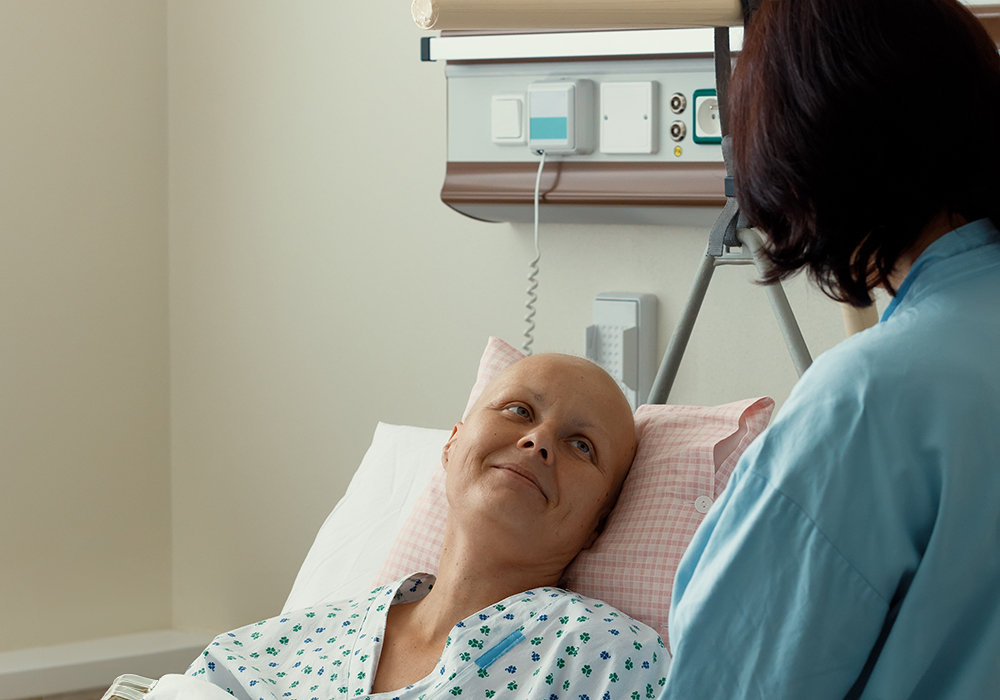Although incidence varies by cancer type, approximately 20%–87% of patients experience cachexia during their cancer journey. Affecting nearly every patient with advanced cancer, cachexia is attributed to 20% of cancer-related deaths.
In an article for the Clinical Journal of Oncology Nursing (CJON), ONS member Amanda French, MSN, CRNP, AGACNP-BC, OCN®, BMTCN®, provided an overview of cachexia in patients with cancer and discussed the oncology nurse’s role in screening, educating, collaborating on interprofessional care, monitoring, and providing psychosocial support to patients and their caregivers throughout the continuum of cachexia care.
Pathophysiology
Characterized by “metabolic dysregulation, inflammation, and reduced food intake that results in skeletal muscle loss, cachexia results in decreased skeletal muscle, followed by a decline in adipose tissue and cardiac muscle,” French wrote. Patients experience systemic inflammation, negative protein–energy balance, and involuntary loss of lean body mass.
Cachexia can be either primary or secondary. Primary cachexia occurs because of abnormal metabolism from the tumor’s proinflammatory cytokines, French said, “including a shortage of muscle amino acids, hypothalamic appetite decrease, and induction of insulin resistance in the liver, which leads to abnormal glucose and fat metabolism.” The subsequent energy imbalance results in weight loss, decreased physical functioning, and worsening symptoms such as anorexia, fatigue, pain, and depression.
Secondary cachexia occurs from symptoms and side effects of cancer and its treatment, including anorexia, mucositis, dysphagia, pain, dysgeusia, xerostomia, nausea, diarrhea, constipation, malabsorption, early satiety, depression, and other causes of malnutrition, such as food insecurity. The subsequent decreased oral intake contributes to weight loss.
Cachexia is further subdivided into three stages:
- Precachexia: Weight loss of greater than 5%, anorexia, and metabolic changes
- Cachexia: Weight loss of greater than 5% in the past six months or weight loss of greater than 2% for those with a body mass index less than 20 kg/m2, sarcopenia and any degree of weight loss, reduced oral intake, and inflammation
- Refractory cachexia: Nonresponsive to treatment; associated with poor performance status and a three-month life expectancy
Screening and Assessment
Clinical practice guidelines recommend “routine screening with a validated tool for all patients undergoing anticancer treatment and assessment of at-risk patients at regular intervals for metabolic, nutritional, and other impairments that may endanger their nutritional status,” French said. Tools to assess nutritional risk include:
- Patient-Generated Subjective Global Assessment
- Malnutrition Universal Screening Tool
- Nutritional Risk Screening 2002
- Malnutrition Screening Tool
- Short Nutritional Assessment Questionnaire
Management
Nonpharmacologic: Patients should be referred to a registered dietician at the first signs of cachexia, French said, because early interventions achieve the best outcomes. However, the lack of oncology-specialized dieticians may be a barrier to accessing optimal care. French emphasized the importance of oncology-specific nutrition training (see sidebar) for dietitians, nurses, and other clinicians to close the gap.
Exercise may also be beneficial, although it’s still under investigation, French said. “Although there is insufficient evidence to assess exercise’s direct impact on cachexia, it is well established that exercise can help improve fatigue, aerobic fitness, functional status, and overall quality of life. In addition, exercise may help reduce the incidence and severity of sarcopenia, a gradual and progressive loss of skeletal muscle mass leading to reduced strength.” Because of its effect on many other common cancer symptoms, French suggested incorporating it in patients’ holistic cancer care plan.
Pharmacologic: Several medications to mitigate the effects of cachexia, including ghrelin receptor agonists, prokinetics, androgens, olanzapine, cannabinoids, nonsteroidal anti-inflammatory drugs, omega-3 fatty acids, progestins, corticosteroids, are currently under study, French said. Additionally, short-term dexamethasone may temporarily improve appetite and cancer-related fatigue, although optimal dosing and duration are unclear. However, only two agents are recommended in clinical practice guidelines: corticosteroids and megestrol (a progestin).
“Oncology nurses are well positioned to intervene in all aspects of cachexia care,” French said. For example, acute care, community-based, telehealth, ambulatory, and homecare nurses can screen patients for cachexia and manage them with ongoing monitoring, refer them for early nutritional counseling and physical therapy, and provide education and emotional support. Nurse navigators and nurse practitioners can conduct initial and follow-up screening and assessments during their regular patient visits, reducing the burden of additional appointments, French added. “In addition, oncology nurses can advocate for enhanced training and education regarding cancer cachexia and how to navigate difficult conversations.”
Finally, don’t forget caregivers: Caregivers may be more concerned by anorexia and other symptoms than patients, a phenomenon known as eating-related distress. “It includes many intersecting factors, such as the patient’s and caregiver’s struggle to cope with cachexia, impaired food intake, relationship disturbance, and changing roles,” French said. Clinical practice guidelines recommend open communication with patients and caregivers as cachexia evolves and early integration of palliative care.
For more information on cancer cachexia, refer to the full CJON article and the resources listed in the sidebar.






